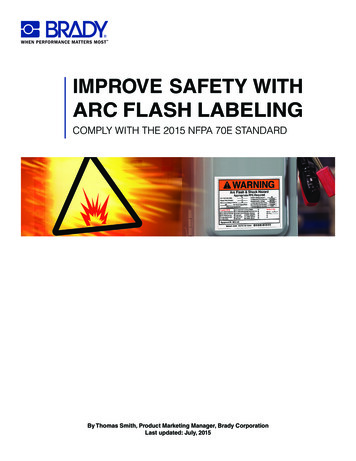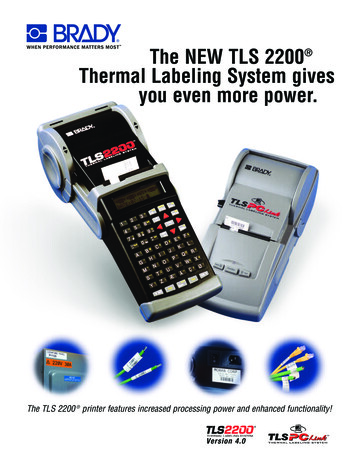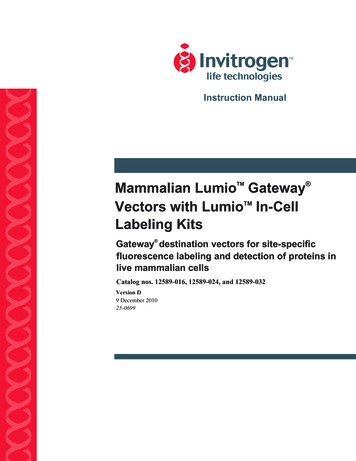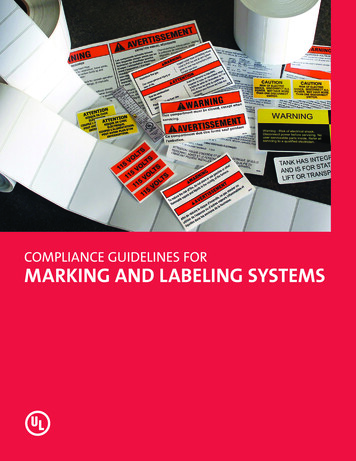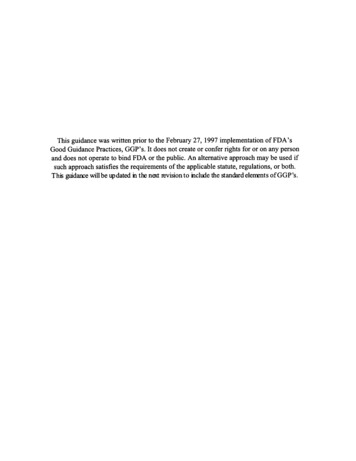
Transcription
This guidance was written prior to the February 27, 1997 implementation of FDA'sGood Guidance Practices, GGP's. It does not create or confer rights for or on any personand does not operate to bind FDA or the public. An alternative approach may be used ifsuch approach satisfies the requirements of the applicable statute, regulations, or both.This guidance will be up dated in the next revision to include the standard elemnt s of GGP 's .
LabelingRegulatory Requirements for Medical DevicesU.S. DEPARTMENT OF HEALTH A N D H U M A N SERVICESPublic Health ServiceFood and Drug Administration
CDRH PUBLICATIONS - MEDICAL DEVICESPublications of the Center for Devices and Radiological Health (CDRH) are available as papercopies from either the U.S. Government Printing Office (GPO) or the National Technical InformationService (NTIS) a s indicated by the GPO or PB prefix, respectively, on the ordering number. Publications a r e also available in microfiche from NTIS a t 5.95 per copy. To receive all CDRH reports inmicrofiche, a t 1.35 each, you may establish a deposit account with NTIS and request automaticdistribution of "FDAIHFZ reports under the "Selected Research in Microfiche" program. Publications without GPO or PB numbers are available only from the Center for Devices and RadiologicalHealth.Addresses for ordering are: Superintendent of Documents, U.S. Government Printing Office,Washington, D.C. 20402; National Technical Information Service, Springfield, VA 22161 (outsideNorth America, prices are d o u b l e those listed); and Center for Devices and Radiological Health,Food and Drug Administration (HFZ-265), 5600 Fishers Lane, Rockville, MD 20857. All prices aresubject to change.FDA 84-4190FDA 84-4191FDA 84-4192FDA 85-4169FDA 85-4192FDA 85-4193FDA 85-4194FDA 85-4195FDA 85-4196FDA 85-4199FDA 86-4159FDA 86-4163FDA 86-4201FDA 86-4202FDA 86-4203FDA 86-4204FDA 86-4205An Investigation of Cerebrospinal Fluid Shunt Valves - Test Results for TwentyFive Valves: Final Report - Phase 111 (PB 84-207042, 22.95).Medical Device GMP Guidance for FDA Investigators.Problem Definition Study on Liquid Crystal Forehead Temperature Strips (PB 84187483, 16.95).Toxic Shock and Tampons (pamphlet).Toxic Shock Syndrome (poster).BMD Standards Survey 1982 - International Edition (PB 85-171155/AS, 34.95).An Overview of the Medical Device Reporting Regulation (PB 86-109709/AS, 9.95).Surface Cracking of Polyurethane Tubing Resulting from Subcutaneous Implantation in Dogs (PB 85-171619/AS, 11.95).Medical Device Problem Reporting and the Health Care Professional (pamphlet).Medical Device Establishment Registration: Information and Instructions (PB 86123726/AS, 9.95,8 pp).Investigational Device Exemptions - Regulatory Requirements for Medical Devices .(supersedes FDA 83-4159) (PB 86-184942/AS, 16.95).Registration and Listing - Regulatory Requirements for Medical Devices (April1986) (supersedes FDA 83-4163) (PB 86-191939/AS, 11.95).Problem Definition Study: Rubella Antibody Testing (PB 86-131935/AS, 9.95, 40PP).To Cement or Not to Cement? or Has the FDA Approved the Use of This Device?(flyer).Labeling - Regulatory Requirements for Medical Devices (GPO 017-012-00327-3, 2.75) (PB 86-184348/AS, 11.95).An Interlaboratory Comparison of Analytical Methods for Ethylene Oxide (PB 86181856/AS, 9.95).Accidental Breathing Systems Disconnections (January 1986lFinal Report) (PB 86185204/AS, 22.95).(Continued on inside back cover)
HHS Publication FDA 89-4203LabelingRegulatory Requirements for Medical DevicesPrepared by theDivision of Small Manufacturers AssistanceOffice of Training and AssistanceProject OfficerThomas CardamoneAugust 1989(This publication supersedes FDA 86-4203)U.S. DEPARTMENT OF HEALTH A N D H U M A N SERVICESPublic Health ServiceFood and Drug AdministrationCenter for Devices and Radiological HealthRockville, Maryland 20857For sale by the Superintendent of Documents, U.S.Government Printing Office, Washington, D.C. 20402
FOREWORDIn October 1982, the Food and Drug Administration established the Center forDevices and Radiological Health (CDRH) by merging the Bureau of Medical Devices andthe Bureau of Radiological Health.The Center develops and implements national programs to protect the public healthin the fields of medical devices and radiological health. These programs are intended toassure the safety, effectiveness and proper labeling of medical devices, to controlunnecessary human exposure to potentially hazardous ionizing and nonionizing radiation,and to ensure the safe, efficacious use of such radiation.The Center publishes the results of its work in scientific journals and in its owntechnical reports. These reports provide a mechanism for disseminating results ofCDRH and contractor projects. They are sold by the Government Printing Office and/orthe National Technical Information Service.We welcome your comments and requests for further information.ohn C. Villfo hDirectorCenter for Devices andRadiological Healthb'
PREFACEThis publication explains label and labeling regulations and requirements formedical devices. The Food and Drug Administration has many labellfig-relatedrequirements to help assure that devices are used safely and effectively, including,but not limited to, provisions on misbranding in Section 502 of the Food, Drug, andCosmetic (FDhC) Act. This publication explains such topics as advertising matteras labeling, what is false and misleading labeling, how prominent labelinginformation must be, what inforfiation must appear on containers as well as outsidelabels, adequate directions for dbe, prescription device requirements, and speciallabeling for particular devices or types of devices and uses.The Medical Device Amendmhts to the FD&C Act mandated the establishmentof ".an identifiable office to ptovide technical and other non-financial assistanceto small manufacturers of medical devices to assist them in complying with therequirements of the Food, Drug, and Cosmetic Act." The Division of SmallManufacturers Assistance (DSMA) was established to meet these requirements. Inaddition to providing individual guidance and workshops, DSMA distributes a widevariety of printed materials such as regulations, policy statements, question-andanswer booklets, and other FDA documents that help manufacturers understand thesubstance and impact of FDA requirements, as well as the simplest or mosteffective ways to meet them. This publication contains explanations and examplesof ways that companies can readily comply with labeling requirements. We hope theinformation contained in this publication will alert manufacturers to FDA labelingrequirements, and prompt them to ask any questions they may have. Feel free tovisit, write, or call DSMA toll free at 800-638-2041. The local phone number is(301) 443-6597.V Joseph9. ArcareseDirectorOffice of Training and Assistance
ABSTRACTDivision of Small Manufacturers Assistance, Office of Training and Assistance, Centerfor Devices and Radiological Health. Labeling: Regulatory Requirements for MedicalDevices. HHS Publication FDA 89-4203 (August 1989) (pp. 43).This publication is Chapter 6 of the "Regulatory Requirements for MedicalDevices - A Workshop Manual." It covers labeling requirements that devicemanufacturers, reconditioners, repackers, and relabelers must consider when aproduct requires labeling. Such labeling may include adequate instructions foruse, servicing instructions, adequate warnings against uses that may be dangerous to health, or information that may be necessary for the protection of users.
CONTENTS.INTRODUCTION .Labels and Labeling .Misbranding .False o r Misleading Labeling .GENERALDEVICELABELING .Introduction .General Labeling Provisions .Labeling Requirements f o r Over-the-counter (Non-Prescription) Devices .Exemptions from Adequate Directions f o r Use .O t h e r Exemptions .Labeling Requirements f o r Specific Devices .IN VITRO DIAGNOSTIC PRODUCT LABELING .Introduction .Label Requirements f o r t h e Immediate Container .Labeling Requirements f o r Inserts and O u t e r Packaging .Exemptions from Labeling Requirements .Labeling of General Purpose Laboratory Reagents and Equipment .LABELING FOR INVESTIGATIONAL AND 510(K) DEVICES .Introduction .Premarket Notification [510(k)] Labeling .IDE Device Labeling Requirements .GOOD MANUFACTURING PRACTICE LABELING REQUIREMENTS .Introduction .General Device Labeling Requirements .Additional Labeling Requirements f o r Critical Devices .Sterile Device Labeling .Contract Sterilization .RADIATION-EMITTING DEVICE LABELING .Introduction .General Labeling Requirements f o r Electronic Products .Ionizing Radiation-Emitting Products .Light-Emitting Products .Ultrasonic Radiation-Emitting Products .GOVERNMENT CONTRACT DEVICE LABELING REQUIREMENTS .Introduction .Labeling Specifications .DEVELOPMENT O F DEVICE LABELING .Introduction .Labeling Problems .Reducing Labeling Problems .ForewordPrefaceAbstractSample of Approval Form for Labeling. Advertising Literature. E t 02223242525262728343535363737373943
INTRODUCTIONThe United States Food and Drug Administration develops and administers regulationsunder authority granted by laws passed by Congress that apply to food, drugs, cosmetics,biologics, radiat on-emitting electronic products, and medical devices. Of the fourteenlaws currently administered by FDA, three directly address the labeling of medicaldevices:o The Food, Drug, and Cosmetic (FD&C) Act - The FD&C Act applies to food, drugs,cosmetics, biologics, and medical devices. Section 201 defines the terms "label"and "labeling" as they ap ly to medical devices and draws a distinction betweenthese terms. Section 502( ) ( I ) and (2) requires that device labeling bear adequatedirections for use, operating and servicing instructions, and either adequatewarnings a ainst dangerous uses to health, or information necessary for theprotection o users.?Bo The Fair Packaging and Labeling Act (FPLA) - Because medical devices had previouslybeen defined and regulated by the FD&C Act, Section 5 of the subsequentlyimplemented FPLA Act refers to and makes use of the terms "label" and "labeling."Requirements of the FPLA apply to over-the-counter medical devices distributed byretail outlets.o The Radiation Control for Health and Safety Act (RCHSA) - Section 358(h) of theRCHSA requires manufacturers or distributors of radiation-emitting electronicproducts, including medical devices, to place certification labeling on theirdevices.The specific requirements of the above laws are implemented by the Secretary of theDepartment of Health and Human Services (DHHS) in the form of regulations. Initially, FDAwhlch is a part of DHHS, drafts proposed regulations. These proposed regulations are thensubmitted by the Commissioner of the FDA to the Office of Management and Budget. After therequired time frames for public comment have elapsed, these regulations are redrafted orresubmitted, and may eventually result in finalized labeling regulations. Finalregulations are published in the FEDERAL REGISTER (FR) and have the force of law.Labeling regulations promulgated under the above Acts which pertain to medical devicesare currently found in the following Parts of Title 21 of the Code of Federal Regulations(CFR).oooooGeneral Device Labeling - 2 1 CFR PART 801In Vitro Diagnostic Products - 21 CFR PART 809Investigational Device Exemptions - 2 1 CFR PART 8 12Good Manufacturing Practices - 2 1 CFR PART 820General Electronic Products - 2 1 CFR PART 1010Each of these parts or categories will be covered in detail in following sections ofthis chapter; however. before continuing, a few brief concepts and definitions from eachAct applicable to labeling are discussed.The FD&C Act is the primary law under which the FDA takes action against regulatedproducts. Specifically:o Sections 20 I (k) through 20 1 (m) of the FD&C Act address labeling "definitions. "
o Sections within Chapter 111 of the FD&C Act address prohibited acts with respect tofood, dru s, cosmetics, and medical devices. These prohibitions deal with two majorareas: "a ulteration" and "misbranding."fo Sections within Chapter V of the FD&C Act set forth specific instances wherebydru s or devices will be considered to be adulterated or misbranded by the FDA. TheRa lation Control for Health and Safety Act applies both to medical and otherradiation-emitting electronic devices. Labeling regulations based on this lawpertain to FDA certification of electronic products and are found under 21 CFR PartC10 10.The medical aspects of the FPLA ap ly only to medical devices intended for sale toconsumers from retail outlets. This Act re ers to many sections of the FD&C Act. Labelingregulations based on the FPLA are found under 2 1 CFR Part 801.PThe RCHSA applies both to medical and other radiation-emittin electronic devices.Labeling regulations based on this law pertain to FDA certification o electronic productsand are found under 2 1 CFR Part 1010.fLABELS AND LABELINGSection 201 of the FD&C Act distinguishes between label and labelinCertainprovisions in Chapter V of the FD&C Act apply specifically to the "label" of t e device,others are related to its "labeling." These terms are related, but not interchangeable. Ofthe two, the term "label" is more restricted. Generally, it consists of that art of thedisplay confined to the device itself. On the other hand, "labeling" deals wit the labelon the device, and descriptive and informational literature that accompanies the device.tRSection 201 (k) defines "label" as a:o "display of written, printed, or graphic matter upon the immediate container of anyarticle. ."The term "immediate container" does not include package liners. Any word, statement,or other information appearing on the immediate contamer must also appear "on the outsidecontainer or wrapper, lf any there be, of the retail package of such article, or is easilylegible through the outside container or wrapper. "Section 20 1 (m) defines "labeling" as:o "all labels and other written, printed, or graphic matter( 1 ) upon any article or any of its containers or wrappers, or(2) accompanyin such article" at any time while a device is held for sale aftershipment or elivery for shipment in interstate commerce.dThe term "accompanying" is interpreted liberally to mean more than physicalassociation with the product. It extends to posters, tags, pamphlets, circulars, booklets,brochures, instruction books, direction sheets, fillers, etc. "Accompanying" also includeslabeling that is brought together with the device after shipment or delivery for shipmentin interstate commerce.
Labeling and AdvertisingThe distinction between labeling and advertising, both of which draw attention to thearticle to be sold, is often superfic alor nebulous. Both are used for a similar purpose,i.e.? to provide information about the product. Thus, according to an appellate courtdecision: "Most, if not all advertising, is labeling. The term 'labelint' is defined inthe FD&C Act as including all printed matter accompanyin any article. ongress did not,and we cannot, exclude from the definition printed matter w ich constitutes advertising."tMISBRANDINGSection 502 of the FD&C Act contains provisions on misbranding and false or misleadinglabeling. Specific re uirements and exemptions are contained in regulations promulgatedunder this Act as wi 1 be discussed in forthcoming sections in this chapter. A device ismisbranded if:9o Its labeling is false or misleading in any particular;o It is in packa e form and its label fails to contain the name and place of businessof the manu acturer, packer, or distributor; and an accurate statement of thequantity of the contents in terms of weight, measure, or numerical count;Bo Any required wording is not prominently displayed as compared with other wording onthe device, or is not clearly stated;o Its label does not bear adequate directions for use including warnings against usein certain pathological conditions; or by children where its use ma be dangerousto health; or against unsafe dosage, or methods, or duration of a ministration orapplication ;Bo It is dangerous to health when used in the dosage or manner or with the frequencyor duration prescribed, recommended or suggested in the labeling; oro It does not comply with the color additives provisions listed under Section 706 ofthe Act.Sections 502 and 706 of the FD&C Act predate the medical device amendments and applyequally to food, drug, cosmetic, veterinary drugs, and biolo ics. The Medical DeviceAmendments of 1976 provided new authority for dealin specifica ly with the misbranding ofmedical devices. These additional provisions liste below state under what furthercircumstances a device is misbranded.dfo If the device's established name (if it has one), its name in an officialcompendium, or any common or usual name is not prominently printed in type at leasthalf as large as that used for any proprietary name;o If the device is subject to a performance standard and it does not bear thelabeling prescribed in that standard;o If there is a failure or refusal to comply with any requirement rescribed underthe FD&C Act, Section 5 18 on notification and other remedies, or ailure to furnishany materials or information requested by or under Section 519 on reports andrecords; orF
o If it has any representation that creates an impression of official approvalbecause of the possession by the firm of an FDA registration or premarketnotification number.FALSE OR MISLEADING LABELINGSection 502(a) declares that a drug or device is misbranded if its labeling provesfalse or misleading in any particular. The phrase "false or misleading" is not confined inmeaning to untrue, forged, fraudulent, or dece tive. In fact, the word, statement, orillustration may be true in the strict sense of t e word; however, the labeling can bedeemed by the FDA to be in violation of the law if it proves deceptive to the customer. Itis not a necessary condition that the labeling should be flatly and baldly false; the word"misleadin!"in the Act means that labeling is deceptive if it is such as to create orlead to a alse impression in the mind of the reader. A "false im ression" may result notonly from a false or deceptive statement, but may also be insti led in the mind of thepurchaser b ambi uity or misdirection. It may also be caused by failure to inform theconsumer o facts t at are relevant to those statements actually made. In other words, thelabel that remains silent as to certain consequences may be as deceptive as the label thatcontains extravagant claims.grP1A device can be misbranded by making reference to a medical device registration, or a510(k) premarket notification number assi ned by FDA in response to a firm's filingrequirements under the FD&C Act. Section tf07.39 of 21 CFR, Misbranding by reference toestablishment registration or registration number, and 807.97 of 2 1 cfr, misbranding byreference to premarket notification, state that the assigned numbers do not constituteofficial FDA approval of the device. Additionally, any representation that connotes FDAapproval as a result of complying with the devlce regulations is misleading andconstitutes misbranding.Similiarly, a device can be misbranded by reference to an Investigational DeviceExemption (IDE) or Premarket Approval (PMA). Section 301 (I) prohibits the use on labelingof any device, or in any advertising relatin to such device, of any representation orsuggestion or approval of an application wit respect to such device is In effect underSection 5 15, IDE or Section 520(g), PMA.1Examples of false representations are:o incorrect, inadequate or incomplete identification;o unsubstantiated claims of therapeutic value;o inaccuracies concerning condition, state, treatment, size, shape or style;o substitution of parts or material; ando use of the prefix "U.S." or other similar indication suggesting Government orAgency approval or endorsement of the product.Examples of misleading labeling include:o ambiguity, half-truths, and trade puffery;o expressions of opinion or subjective statements; and
o failure to reveal material facts, consequences that may result from use, or theexistence of difference of opinion.Examples of other objectionable labeling practices include:oooodeceptive pictorial matter;misleading testimonials;misleading list of parts or components; anduse of brand or trade names instead of "established names."GENERAL DEVICE LABELINGINTRODUCTIONThe general labeling re uirements for medical devices are contained in 21 CFR Part801. These regulations speci y the minimum requirements for all devices. Later sections inthis chapter discuss any additional requirements needed for specific categories ofdevices.BGENERAL LABELING PROVISIONSName and Place of Business (801.1)o The label of a device shall contain the name and place of business of manufacturer,packer, or distributor including the street address, city, state, and zip code.o If the firm's street address is in the local telephone directory, the streetaddress can be omitted.o If the firrn listed on the label is not the manufacturer, the firrn information mustbe qualified by an appropriate statement such as, "Manufactured for ." or"Distributed by. ."Intended Use (801.4)o If a packer, distributor, or seller intends a device for uses other than thoseintended by the person from whom he received the device, these parties must furnishadequate labeling in accordance with the new intended use.o If a manufacturer knows or has information indicating that his device is to be usedfor conditions or purposes other than which it was intended, he is required toprovide adequate labeling in accordance with such other uses. (An example of thismight be a manufacturer of dental X-ray equipment who is routinely selling hisproduct to podiatrists.)Adequate Directions (80 1.5)o "Adequate directions for use" means directions under which the layman can use adevice safely and for the purposes intended. This includes:-Statements of all purposes for which and conditions under which the device canbe used;
- Quantity of dose for each use and usual quantities for persons of different agesand physical conditions;-Frequency of administration;-Duration of application;-Time of administration in relation to other factors;-Route or method of application; and-Any preparation necessary for use.False or Misleading Statements (801.6)o A device is misbranded if it makes a false or misleading statement with respect toanother device, drug, food, or cosmetic.Prominence of Statements (80 1.15)o A word, statement or other required information may lack the required prominenceand conspicuousness for the following reasons:-If it fails to appear on the part or panel that is displayed under customaryconditions of purchase;-If the package contains sufficient space and the required information fails toappear on two or more panels, each of which is designed to render it to bed splayedunder customary conditions of purchase;-Failure to extend required labeling over package space provided;-Lack of sufficient label space for required labeling due to placement of nonrequired labeling on the package; or-Smallness or style of type, insufficient contrast between labeling and packagebackground, designs which obscure labeling, or overcrowding of labeling whichrenders it unreadable.o Exemptions may be granted in those instances where device labeling lacks sufficientspace for required labeling provided that:-Existing label space is not taken up by includin non-required information or bygiving prominence to a portion of the required la eling; and-Existing label space is not used for any representations in a foreign language.%o All labeling shall be in English with the exception of products distributed solelywithin Puerto Rico or a U.S. territory where the predominant Ian uage is other thanEnglish. In these instances the predominant language may e substituted forEnglish.%-If any representation on the device label or labeling a pears in a foreignlanguage, then all required labeling shall also appear in that oreign language.P
LABELING REQUIREMENTS FOR OVER-THE-COUNTER (NON-PRESCRIPTION)DEVICESPrincipal Display Pane1 (80 1.60)o The principal display panel is that portion of the label which is intended to bedisplayed, presented, shown, or examined under customary conditions for retailsales. The area of the principal display panel is considered to be:-In the case of a rectangular package, the height x width of one side;-In the case of a cylindrical or nearly cylindrical package, 40% of height xcircumference; or-In the case of any other shapes, 40% of the total surface area of the container,unless a more prominent site exists.Statement of Identity (80 1.61)o The statement of identity of the device must be listed on the principal displaypanel.-It must list the common name of the device followed by a statement of itsprincipal intended action(s);-Indications for use must be listed in the directions for use: and- The statement must be in bold t pe, reasonably related in size to the mostprominent printed matter on the isplay anel, and must be in lines generallyparallel to the base of the package on whic it rests.!Net Quantity of Contents Statement (80 1.62)o The label of an over-the-counter (OTC) device in ackage form must contain a statement of net quantity of contents in terms of weig t , measure, numerical count; or acombination of numerical count and weight, measure, or size, which are describedbelow:i'-Count - If the declaration by count does not give accurate information as to thequantity, it shall be augmented by statements of weight, measure, or size;-Measure - In cases of established customer usage and trade custom where units oflinear measure or measure of area are used, they shall be augmented whennecessary with statements of weight measure or size. Liquid measure is to beexpressed in terms of the U.S. gallon of 23 1 cu. in. and quart, pint, and fluidounce subdivisions, and shall express the volume at 68 degrees Farenheit; and-Weight - Terms of weight are to be expressed in avoirdupois ound and ounce.Units of metric weight or measure are considered su plement.!a The declarationmay contain common or decimal fractions. Common ractions shall be reduced tothe rlowest terms.P
-Placement - The declaration shall appear as a separate item on each principaldisplay panel; and be separated by at least a space equal to the height of thelettering used in the declaration, from other information appearin above andbelow, and separated by at least twice the width of the letter "N" rom labelingto the left or nght.Bo The height, ratio, and placement of letterin required on the principal displaypanel are a function of a number of variab es related to package slze, shape,composition, and the method of affixing the required labeling. This is described indeta lunder 2 1 CFR 80 1 .62 (g) to (k).fEXEMPTIONS FROM ADEQUATE DIRECTIONS FOR USEPrescription Device (80 1.109)0 A device which, because of any potentiality for harmful effect, or the supervisionof the method of its use, or the collateral measures necessary to its use is notsafe unless under a practitioner licensed by law to direct use of this device, andhence for which "adequate directions for use" cannot be written, is exempt fromsuch provided:-It is in the possession of either a licensed practitioner or persons lawfullyengaged in the manufacture or distribution of the product;-Its labeling bears an Rx statement, i.e., "Caution: Federal law restricts thisdevice to sale by or on the order of a(insert name of physician, dentist,or other licensed ractitioner) :"-Its labeling bears information for use including, indications, effects, routes,methods, and frequency and duration of administration, and an relevant hazards,contraindications, side effects, and precautions under whici the device cansafely be used; and- All labeling other than labels and cartons bears the date of issuance or date ofthe latest revision.Retail Exemption (801.110)o A device which is delivered to the ultimate user by a licensed practitioner in thecourse of his practice or upon prescription are requlred only to bear the name andaddress of the practitioner, directions for use, and any required cautionarystatements.Commonly Known Directions (80 1.1 16)o A device is exempt from adequate directions for use if adequate directions forcommon uses are known to the ordinary individual.In Vitro Diagnos
An Overview of the Medical Device Reporting Regulation (PB 86-109709/AS, 9.95). Surface Cracking of Polyurethane Tubing Resulting from Subcutaneous Implanta- tion in Dogs (PB 85-171619/AS, 11.95).

